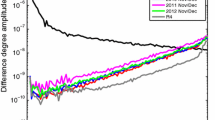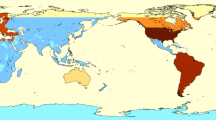Abstract
Several techniques have been proposed to exploit GNSS-derived kinematic orbit information for the determination of long-wavelength gravity field features. These methods include the (i) celestial mechanics approach, (ii) short-arc approach, (iii) point-wise acceleration approach, (iv) averaged acceleration approach, and (v) energy balance approach. Although there is a general consensus that—except for energy balance—these methods theoretically provide equivalent results, real data gravity field solutions from kinematic orbit analysis have never been evaluated against each other within a consistent data processing environment. This contribution strives to close this gap. Target consistency criteria for our study are the input data sets, period of investigation, spherical harmonic resolution, a priori gravity field information, etc. We compare GOCE gravity field estimates based on the aforementioned approaches as computed at the Graz University of Technology, the University of Bern, the University of Stuttgart/Austrian Academy of Sciences, and by RHEA Systems for the European Space Agency. The involved research groups complied with most of the consistency criterions. Deviations only occur where technical unfeasibility exists. Performance measures include formal errors, differences with respect to a state-of-the-art GRACE gravity field, (cumulative) geoid height differences, and SLR residuals from precise orbit determination of geodetic satellites. We found that for the approaches (i) to (iv), the cumulative geoid height differences at spherical harmonic degree 100 differ by only \({\approx }10~\%\); in the absence of the polar data gap, SLR residuals agree by \({\approx }96~\%\). From our investigations, we conclude that real data analysis results are in agreement with the theoretical considerations concerning the (relative) performance of the different approaches.







Similar content being viewed by others
References
Badura T (2006) Gravity field analysis from satellite orbit information applying the energy integral approach. PhD Thesis, Graz University of Technology, Austria
Badura T, Sakulin C, Gruber C, Klostius R (2006) Derivation of the CHAMP-only global gravity field model TUG-CHAMP04 applying the energy integral approach. Stud Geophys Geod 50:59–74. doi:10.1007/s11200-006-0002-3
Baur O (2013) Greenland mass variation from time-variable gravity in the absence of GRACE. Geophys Res Lett 40:4289–4293. doi:10.1002/grl.50881
Baur O, Reubelt T, Weigelt M, Roth M, Sneeuw N (2012) GOCE orbit analysis: long-wavelength gravity field determination using the acceleration approach. Adv Space Res 50:385–396. doi:10.1016/j.asr.2012.04.022
Beutler G, Jäggi A, Mervart L, Meyer U (2010a) The celestial mechanics approach: theoretical foundations. J Geod 84:605–624. doi:10.1007/s00190-010-0401-7
Beutler G, Jäggi A, Mervart L, Meyer U (2010b) The celestial mechanics approach: application to data of the GRACE mission. J Geod 84:661–681. doi:10.1007/s00190-010-0402-6
Bock H, Jäggi A, Meyer U, Visser P, van den IJssel J, van Helleputte T, Heinze M, Hugentobler U (2011) GPS-derived orbits for the GOCE satellite. J Geod 85:807–818. doi:10.1007/s00190-011-0484-9
Bruinsma SL, Förste C, Abrikosov O, Marty J-C, Rio M-H, Mulet S, Bonvalot S (2013) The new ESA satellite-only gravity field model via the direct approach. Geophys Res Lett 40:3607–3612. doi:10.1002/grl.50716
Ditmar P, van Eck van der Sluijs A (2004) A technique for modeling the Earth’s gravity field on the basis of satellite accelerations. J Geod 78:12–33. doi:10.1007/s00190-003-0362-1
Ditmar P, Kuznetsov V, van Eck van der Sluijs AA, Schrama E, Klees R (2006) DEOS\_CHAMP-01C\_70: a model of the Earth’s gravity field computed from accelerations of the CHAMP satellite. J Geod 79:586–601. doi:10.1007/s00190-005-0008-6
Ditmar P, Klees R, Liu X (2007) Frequency-dependent data weighting in global gravity field modeling from satellite data contaminated by non-stationary noise. J Geod 81:81–96. doi:10.1007/s00190-006-0074-4
Drinkwater MR, Haagmans R, Muzi D, Popescu A, Floberghagen R, Kern M, Fehringer M (2007) The GOCE gravity mission: ESA’s first core Earth explorer. In: Proceedings of 3rd international GOCE user workshop, Frascati, Italy, ESA SP-627, pp 1–8
Durbin J (1960) The fitting of time series models. Rev Int Stat Inst 28:233–244
EGG-C (2006) GOCE L1b products user handbook. GOCE-GSEG-EOPG-TN-06-0137, Issue 1.1
EGG-C (2010) GOCE Level 2 product data handbook. GO-MA-HPF-GS-0110, Issue 4.3
Engeln-Müllges G, Reutter F (1987) Numerische Mathematik für Ingenieure. BI Wissenschaftsverlag, Zurich (in German)
ESA (1999) The four candidate Earth Explorer Core Missions-Gravity Field and Steady-State Ocean Circulation Mission. ESA SP-1233
ESA (2011) GOCE Newsletter. Issue 2, Rev. 1. Web access. https://earth.esa.int/web/guest/-/goce-newsletters-7007
Flechtner F, Dahle C, Neumayer KH, König R, Förste C (2010) The release 04 CHAMP and GRACE EIGEN gravity field models. In: Flechtner F et al. (eds) System earth via geodetic-geophysical space techniques. Springer, Berlin, pp 41–58. doi:10.1007/978-3-642-10228-8_4
Gerlach C, Sneeuw N, Visser P, Švehla D (2003) CHAMP gravity field recovery using the energy balance approach. Adv Geosci 1:73–80. doi:10.5194/adgeo-1-73-2003
Goiginger H, Pail R (2006) Investigation of velocities derived from satellite positions in the framework of the energy integral approach. In: Proceedings 3rd GOCE user workshop, Frascati, Italy, ESA SP-627, pp 319–324
Goiginger H, Pail R (2010) Covariance propagation of latitude-dependent orbit errors within the energy integral approach. In: Mertikas SP (ed) IAG symposium on gravity, geoid and earth observation, vol 135. Springer, Berlin, pp 155–161. doi:10.1007/978-3-642-10634-7_21
Han S-C, Jekeli C, Shum CK (2002) Efficient gravity field recovery using in situ disturbing potential observables from CHAMP. Geophys Res Lett 29:1789. doi:10.1029/2002GL015180
Hashemi Farahani H, Ditmar P, Klees R, Liu X, Zhao Q, Guo J (2013) The static gravity field model DGM-1S from GRACE and GOCE data: computation, validation and an analysis of GOCE mission’s added value. J Geod 87:843–867. doi:10.1007/s00190-013-0650-3
Heiskanen WA, Moritz H (1967) Physical geodesy. WH Freeman and Company, San Francisco
Jäggi A, Hugentobler U, Beutler G (2006) Pseudo-stochastic orbit modeling techniques for low-Earth orbiters. J Geod 80:47–60. doi:10.1007/s00190-006-0029-9
Jäggi A, Beutler G, Prange L, Dach R, Mervart L (2009) Assessment of GPS-only observables for gravity field recovery from GRACE. In: Sideris M (ed) IAG symposium on observing our changing earth, vol 133. Springer, Berlin, pp 113–123. doi:10.1007/978-3-540-85426-5_14
Jäggi A, Prange L, Hugentobler U (2011a) Impact of covariance information of kinematic positions on orbit reconstruction and gravity field recovery. Adv Space Res 47:1472–1479. doi:10.1016/j.asr.2010.12.009
Jäggi A, Bock H, Prange L, Meyer U, Beutler G (2011b) GPS-only gravity field recovery with GOCE, CHAMP, and GRACE. Adv Space Res 47:1020–1028. doi:10.1016/j.asr.2010.11.008
Jäggi A, Beutler G, Meyer U, Prange L, Dach R, Mervart L (2012) AIUB-GRACE02S—status of GRACE gravity field recovery using the celestial mechanics approach. In: Kenyon S, Pacino MC, Marti U (eds) IAG symposium on geodesy for planet earth, vol 136. Springer, Berlin, pp 161–169. doi:10.1007/978-3-642-20338-1_20
Koch K-R, Kusche J (2002) Regularization of geopotential determination from satellite data by variance components. J Geod 76:259–268. doi:10.1007/s00190-002-0245-x
Kusche J (2003) A Monte-Carlo technique for weight estimation in satellite geodesy. J Geod 76:641–652. doi:10.1007/s00190-002-0302-5
Lemoine FG, Kenyon SC, Factor JK, Trimmer RG, Pavlis NK, Chinn DS, Cox CM, Klosko SM, Luthcke SB, Torrence MH, Wang YM, Williamson RG, Pavlis EC, Rapp RH, Olson TR (1998) The development of the joint NASA GSFC and NIMA geopotential model EGM96. NASA Goddard Space Flight Center, Greenbelt
Mayer-Gürr T (2006) Gravitationsfeldbestimmung aus der Analyse kurzer Bahnbögen am Beispiel der Satellitenmissionen CHAMP und GRACE. PhD Thesis, Rheinische Friedrich-Wilhelms-Universität zu Bonn (in German)
Mayer-Gürr T, Ilk KH, Eicker A, Feuchtinger M (2005a) ITG-CHAMP01: a CHAMP gravity field model from short kinematic arcs over a one-year observation period. J Geod 78:462–480. doi:10.1007/s00190-004-0413-2
Mayer-Gürr T, Feuchtinger M, Kusche J (2005b) A comparison of various procedures for global gravity field recovery from CHAMP orbits. In: Reigber C, et al. (eds) Earth observation with CHAMP–results from three years in orbit. Springer, Berlin, pp 151–156. doi:10.1007/3-540-26800-6_24
Mayer-Gürr T, Kurtenbach E, Eicker A (2010) The satellite-only gravity field model ITG-Grace2010s. http://www.igg.uni-bonn.de/apmg/index.php?id=itg-grace2010
Meissl P (1971) On the linearization of the geodetic boundary value problem. Report 151, Department of Geodetic Science and Surveying, Ohio State University Columbus
O’Keefe JA (1957) An application of Jacobi’s integral to the motion of an earth satellite. Astron J 62:265–266. doi:10.1086/107530
Pail R, Bruinsma S, Migliaccio F, Förste C, Goiginger H, Schuh W-D, Höck E, Reguzzoni M, Brockmann JM, Abrikosov O, Veicherts M, Fecher T, Mayrhofer R, Krasbutter I, Sansò F, Tscherning CC (2011) First GOCE gravity field models derived by three different approaches. J Geod 85:819–843. doi:10.1007/s00190-011-0467-x
Prange L (2011) Global gravity field determination using the GPS measurements made onboard the low earth orbiting satellite CHAMP. Geodätisch-geophysikalische Arbeiten in der Schweiz, 81
Prange L, Jäggi A, Beutler G, Dach R, Mervart L (2009) Gravity field determination at the AIUB–the celestial mechanics approach. In: Sideris M (ed) Observing our changing earth. IAG symposium, vol 133. Springer, Berlin, pp 353–362. doi:10.1007/978-3-540-85426-5_42
Reubelt T (2009) Harmonische Gravitationsfeldanalyse aus GPS-vermessenen kinematischen Bahnen niedrig fliegender Satelliten vom Typ CHAMP, GRACE und GOCE mit einem hoch aufösenden Beschleunigungsansatz. Deutsche Geodätische Kommission, C 632, Verlag der Bayerischen Akademie der Wissenschaften, Munich (in German)
Reubelt T, Austen G, Grafarend EW (2003) Harmonic analysis of the Earth’s gravitational field by means of semi-continuous ephemerides of a low Earth orbiting GPS-tracked satellite. Case study: CHAMP. J Geod 77:257–278. doi:10.1007/s00190-003-0322-9
Reubelt T, Sneeuw N, Grafarend EW (2012) Comparison of kinematic orbit analysis methods for gravity field recovery. In: Sneeuw N et al. (eds) VII Hotine-Marussi symposium on mathematical geodesy. IAG symposium, vol 137. Springer, Berlin, pp 259–265. doi:10.1007/978-3-642-22078-4_39
Reubelt T, Baur O, Weigelt M, Roth M, Sneeuw N (2013) GOCE long-wavelength gravity field recovery from 1s-sampled kinematic orbits using the acceleration approach. In: IAG symposium, vol 141 (accepted)
Schneider M (1968) A general method of orbit determination. Library Translation 1279, Royal Aircraft Establishment, Ministry of Technology, Farnborough, England
Sneeuw N, van Gelderen M (1997) The polar gap. In: Sansò F, Rummel R (eds) Geodetic boundary value problems in view of the one centimeter geoid. Lecture notes earth science, vol 65, Springer, Berlin, pp 559–568. doi:10.1007/BFb0011717
Sośnica K, Thaller D, Jäggi A, Dach R, Beutler G (2012) Sensitivity of Lageos orbits to global gravity field models. Artif Satell 47:47–65. doi:10.2478/v10018-012-0013-y
Švehla D, Rothacher M (2002) Kinematic orbit determination of LEOs based on zero- or double-difference algorithms using simulated and real SST data. In: Adam J et al. (eds) Vistas for geodesy in the new millennium, IAG symposium, vol 125. Springer, Berlin, pp 322–328. doi:10.1007/978-3-662-04709-5_53
Švehla D, Rothacher M (2004) Two years of CHAMP kinematic orbits for geosciences. EGU General Assembly 2004, Geophysical Research Abstracts 6:EGU2004-06645
Tapley BD, Bettadpur S, Watkins M, Reigber C (2004) The gravity recovery and climate experiment: mission overview and early results. Geophys Res Lett 31:L09607. doi:10.1029/2004GL019920
Van Gelderen M, Koop R (1997) The use of degree variances in satellite gradiometry. J Geod 71:337–343. doi:10.1007/s001900050101
Weigelt M (2007) Global and local gravity field recovery from satellite-to-satellite tracking. PhD Thesis, University of Calgary
Weigelt M, van Dam T, Jäggi A, Prange L, Tourian M, Keller W, Sneeuw N (2013) Time-variable gravity signal in Greenland revealed by high-low satellite-to-satellite tracking. J Geophys Res Solid Earth 118:3848–3859. doi:10.1002/jgrb.50283
Welch PD (1967) The use of fast Fourier transform for the estimation of power spectra: a method based on time averaging over short, modified periodograms. IEEE Trans Audio Electroacoust 15:70–73. doi:10.1109/TAU.1967.1161901
Acknowledgments
Precise orbit determination of SLR satellites was accomplished with the software package GEODYN, kindly provided by the NASA Goddard Space Flight Center. Support by Mattias Roth (orbit data preparation) for the PAA results is acknowledged. Furthermore, we thank Roland Pail for implementational details underlying the energy balance approach solutions, as well as Pavel Ditmar and Hassan Hashemi Farahani for discussions concerning the averaged acceleration approach. Last but not least, we are grateful for the comments and suggestions by three anonymous reviewers.
Author information
Authors and Affiliations
Corresponding author
Rights and permissions
About this article
Cite this article
Baur, O., Bock, H., Höck, E. et al. Comparison of GOCE-GPS gravity fields derived by different approaches. J Geod 88, 959–973 (2014). https://doi.org/10.1007/s00190-014-0736-6
Received:
Accepted:
Published:
Issue Date:
DOI: https://doi.org/10.1007/s00190-014-0736-6




